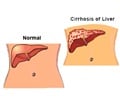Q: Which doctor should I consult for hepatomegaly?
A: A gastroenterologist should be consulted in case of hepatomegaly.
Q: What does it mean when both liver and spleen are enlarged?
A: It means that both the liver and spleen have become bigger than their normal sizes. Liver and spleen share common blood circulation via the hepatic portal system, hence many disease processes affect both organs. Malaria, kala azar, viral hepatitis, obstruction to portal and hepatic veins, cirrhosis, and blood cancer are some known causes.
Q: What is steatosis?
A: Steatosis is deposition of fat in the liver cells. This deposition of fats in the liver leads to an increase in liver size. This condition is reversible in the early stages. If neglected, it may lead to permanent scarring and cirrhosis.
Q: What is non alcoholic fatty liver disease [NAFLD]?
A: It is enlargement of the liver due to fat deposition in people who consume very less alcohol or do not drink alcohol.
Q: What is the normal size of the adult liver?
A: The average width of the liver is around 21 - 22.5 cms. The vertical height is estimated to be 15 - 17.5 cms. From the front to back, the liver measures 10 - 12.5 centimeters.
Q: What is the normal weight of the adult liver?
A: The average weight of the liver is between 1.2 - 1.6 kgs. The liver is about 1/18 of total body weight in the fetus and 1/36 of total body weight in an adult.
Q: Where is the liver located in the body?
A: The liver is a wedge-shaped organ situated in the right upper quadrant of the abdomen. It is just below the diaphragm and hidden by the rib cage. A small portion of the liver extends to the left upper quadrant of the abdomen.
Q: What causes fatty liver?
A: Regular intake of alcohol, obesity, diabetes, intestinal bypass surgery for obesity, starvation, protein malnutrition, drugs such as corticosteroids and tetracycline are common causes.
Q: What are the symptoms of fatty liver?
A: There are usually no specific symptoms in the early stages. Non specific symptoms may include tiredness, nausea, excess weight in abdominal area, an increase in liver enzymes, cholesterol and triglycerides levels.
Q: What is the meaning of hepatomegaly with fatty infiltration?
A: It means enlargement of the liver due to fat deposition in the liver cells. This gives the liver a glazed appearance.
Q: What can be considered excessive alcohol consumption?
A: More than 2 drinks per day for women and 3 drinks per day for men is considered excess alcohol consumption.
One drink is equivalent to:
- 341 ml (12 oz.) of 5% alcohol beer
- 142 ml (5 oz.) of 12% alcohol wine or
- 43 ml (1.5 oz.) of 40% alcohol
Q: How is fatty liver confirmed?
A: Presence of enlarged liver, high levels of liver enzymes, images of liver obtained from ultrasound and CT scan, and liver biopsy confirm fatty liver.
Q: Does eating fatty food lead to fatty liver?
A: No. Eating fatty food itself does not result in fatty liver.
Q: How does excess fat get into the liver cells?
A: It is probably due to an increase in fat extraction from the intestine or transfer of fats from other parts of body to the liver along with reduced breakdown of fat by liver.
Q: What is the effect of diabetes on hepatomegaly?
A: There is an increased risk of developing liver enlargement in people who rely on insulin to control blood sugar. Such cases can be brought under control with a calorie-restricted diet and more conservative use of insulin.










